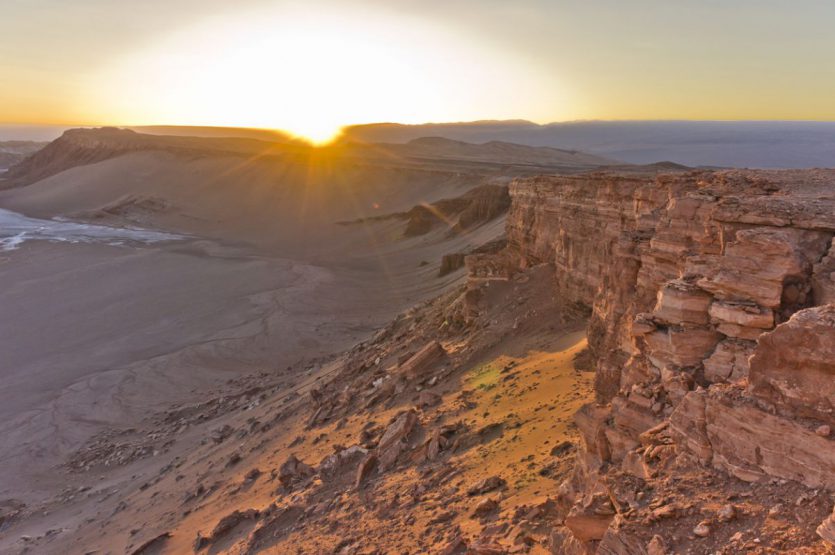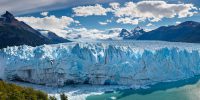
The Atacama Desert is possibly the oldest desert, and it is known as the driest non-polar place on earth: This is because the Atacama Desert has been extremely dry for at least 3 million years. Research by a group of British scientists has shown that some river beds have been dry for as much as 120,000 years.
Characteristics of the Atacama Desert
The desert is a 1600 km long desert plateau covering approximately 105,000 square kilometres and lies at an altitude of more than 2,000 meters, between the mountain ranges of the Andes and the Chilean coastal cordillera. It is also home to high mountains that reach up to 6,000 meters. These are so dry that even at these altitudes there are no glaciers. Only the highest peaks (such as Ojos del Salado, Monte Pissis and Llullaillaco) have a permanent snow cover, even though there is permafrost above 5,600 meters. In some places in the Atacama Desert, there is a marine fog known locally as camanchaca. This provides sufficient moisture for plants such as algae, lichens and cacti.
Most of the desert consists of rocky terrain, salt lakes, sand and rocky lava that flows into the Andes. The valleys of the Atacama Desert, with their different landscapes, are popular destinations for tourists. The Valley of Mars (el valle de Marte), the Valley of the Moon (el valle de la Luna), or the Valley of the Rainbow (el valle del Arcoíris) seem to come from a fantasy world, offering a beautiful view of rugged mountains, and hills with infinite hues.
At night, stargazers are in for a treat, as the Atacama Desert is one of the best places in the world to observe stars and celestial bodies.
The Atacama Desert is full of life!
Although the Atacama Desert seems such an inhospitable place, it is a scenically beautiful place, with stunning, beautifully shaped mountains, turquoise lagoons that are a habitat for important algae and flamingos, as well as columns of boiling water and huge sand dunes.
In addition, there is an uncharacteristic diversity of animals for the arid desert, such as vicuñas, guanacos and llamas, which can be found at over 4,000 meters above sea level in the beautiful plateaus of the Atacama Desert. These animals have adapted perfectly to extreme conditions!
The vegetation of the Atacama Desert varies according to the climatic conditions of the area. Although the desert is mainly characterized by a climate with high temperatures and a lack of rainfall, there are also marginal areas that have higher humidity.
In the drier areas of the desert, we find vegetation adapted to the dry conditions, such as cacti, shrubs, and trees like the tamarugo and the white carob tree. They are all very resistant to desiccation and salinity.
In the more humid areas, the richness and diversity are greater: in fact, one of the most impressive phenomena in the world takes place in the Atacama Desert, known as the “flower desert”. The rainfall caused by “El Niño” results in the germination of more than 200 species of flowers.
But animals are also at home in the Atacama Desert. Depending on the climatic conditions and the nature of the terrain, a variety of arthropods and birds, reptiles, and mammals live in the desert. Among other things, scorpions, caterpillars, nocturnal butterflies, snakes, lizards, guanacos, vizcachas, vicuñas, desert foxes, flamingos, and other birds can be found there.
Natural medicinal springs in the Atacama Desert
Even if you don’t immediately think of water when you hear the word “desert”, water is nevertheless present in the Atacama Desert. Besides the lagoons already mentioned, there are eight staggered natural pools between two rocks at an altitude of 3,590 meters, fed by the Puritama River. The water there is between 25 and 30 degrees Celsius and has medicinal properties. This area is administered by six indigenous communities.
Geysers of Tatio
“The grandfather who cries” is the translation of the geyser field “Tatio“. In the winter months, temperatures there drop to minus 22 degrees Celsius in the morning before sunrise. With an altitude of 4,320 meters, the Tatio geyser field is one of the highest places in the region. To visit the geothermal field, which covers about 30 square kilometers, you have to arrive very early in the morning, as the steam can only be seen at low temperatures. Due to the altitude, and the resulting reduced air pressure, the water here boils at about 86 degrees Celsius!
Around 67 geysers have been discovered, of which about 30 erupt regularly, and some of them produce water fountains up to 10 m high. The geysers are largely intact and form a popular tourist attraction.
The inhabitants of the Atacama Desert
In the villages of the region around the desert, the oldest customs are preserved. San Pedro de Atacama is a tiny desert tourist destination with about 2,000 inhabitants. The village has a small colonial center and a charming street, the “Calle Caracoles”, where all the tourism is concentrated.
Another well-known place, Toconao, is about 40 kilometers from San Pedro de Atacama. Translated, the name Toconao means “place of stones”. According to studies, the place is more than 12,000 years old.
In front of the central square, there is the church and bell tower of San Lucas, originally from the 18th century. Both have been declared national monuments.
Besides tourism, many villagers make a living from making various sculptures from volcanic stone quarried by the indigenous community.
Salar de Atacama
Located just a few kilometers from San Pedro de Atacama, the Salar de Atacama is Chile’s largest salt deposit, as well as one of the region’s most popular tourist attractions.
The Salar de Atacama is 300,000 square kilometers in size and can be seen in its entirety as the air is completely dry.
Beneath the salar is a lake covered by a thick, rough crust of chalky salt. In some places, there are openings in the crust where small lagoons have formed. These are some popular habitats for waterbirds such as flamingos, taguas and guallatas.
The Pukará de Quitor
At the entrance to Quitor, on the top of a hill, is the “Pukará de Quitor” fortress, built in the 12th century by the indigenous population for defensive purposes in response to the expansionist efforts of their Aymara neighbors. In 1982, the fortress was declared a national monument.
The Atacama Desert is an overwhelming experience for any tourist interested in nature and culture. A place that offers an unimagined variety of life forms and natural spectacles. It is definitely worth a trip.
No comments yet
There are no comments on this post yet.




Leave a comment